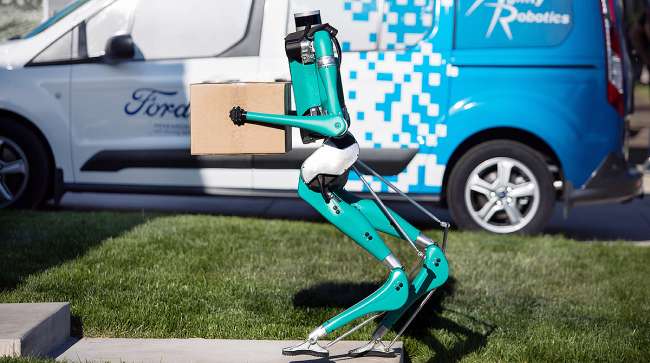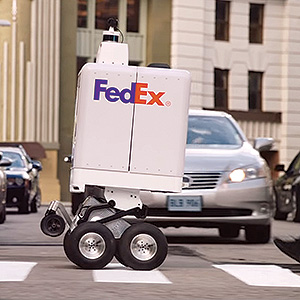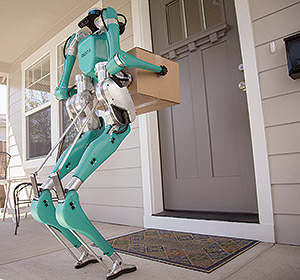Staff Reporter
Ford, Walmart in Group Developing Last-Mile Robots

Human-like robots that can move across sidewalks and climb stairs are on the way to neighborhoods, and they are looking to track down humans. But this scenario is not from the latest sequel to “The Terminator.”
This two-legged, two-armed robot, named Digit, is being produced by the Ford Motor Co. and Agility Robotics of Oregon, and is seeking to deliver goods to consumers. Ford is partnering with Walmart, Postmates and Agility to perfect the robot’s ability to make final-mile deliveries.

FedEx's robot has wheels. (FedEx via YouTube)
“Here’s an understatement: People like online shopping,” Ken Washington, Ford’s chief technology officer, wrote in a Medium blog post. “It’s easy to see why. One-click shopping and perks like two-day delivery are extremely convenient, but they are taking a toll on our cities and neighborhoods.”
Digit is built out of lightweight material, can lift packages that weigh up to 40 pounds, and can walk over rough or uneven terrain, Washington wrote. Its arms are thin, and its hands are globular, with rubbery, bumpy surfaces to help with gripping.
Ford focused on a robot with legs because wheeled robots — like those being tested through a partnership with FedEx and Starship Technologies — cannot always reach certain doors, he said.
Outdoor endurance testing of Digit. v1 runs for up to 3 hours when walking, up to 8 hours of standing around. Future versions will likely have slightly reduced runtime due to dramatically increased computational capacity. pic.twitter.com/TnsiC130KW — Agility Robotics (@agilityrobotics) May 25, 2019
“Gaining access to a customer’s door often requires walking through obstacles, including going up stairs and dealing with other challenges, which can be hard for robots with wheels to do since only about 1% of homes in the United States are wheelchair-accessible, according to the Department of Housing and Urban Development,” Washington wrote. “Digit has been designed to walk upright without wasting energy, so it has no issue traversing the same types of environments most people do every day.”

Digit can lift packages that weigh up to 40 pounds and can walk over rough or uneven terrain. (Ford)
The robots would be deployed from vans or trucks, and would spread out across neighborhoods to complete last-mile deliveries, he said.
But finding places for those vehicles to park so that the robots could make their rounds might prove challenging, noted Amy Moore, a research associate for Oak Ridge National Laboratory’s Transportation Planning and Decision Science Group.
“I wonder how well this system would work in a really urban environment,” Moore told Transport Topics. “Especially if the van has to circle (instead of parking).”
Moore said parking in urban areas is an ongoing problem for delivery giants like FedEx and rival UPS and, a problem not easily solved whether the robots have legs or wheels. “You waste so much time circling blocks,” said Moore.
Washington noted that there is more work to be done with robot deliveries. “We are striving to determine the best way for our self-driving vehicles to cooperate with Digit and understand how this new delivery method can be taken advantage of in the future,” he said, but added that the industry needs “a new way of thinking about how we make deliveries.”
In a video that accompanies Washington’s post, the robot is automatically lifted out of a van as it unfolds itself, then grabs a box, climbs a set of stairs to make a delivery and sends a notification to the homeowner.

